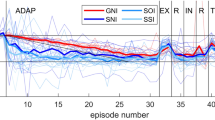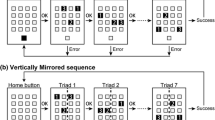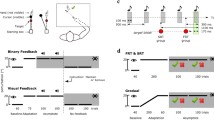Abstract
In the present study, we examined the effects of explicit knowledge, obtained through instruction or spontaneous detection, on the transfer of visuomotor sequence learning. In the learning session, participants learned a visuomotor sequence, via trial and error. In the transfer session, the order of the sequence was reversed from that of the learning session. Before the commencement of the transfer session, some participants received explicit instruction regarding the reversal rule (i.e., Instruction group), while the others did not receive any information and were sorted into either an Aware or Unaware group, as assessed by interview conducted after the transfer session. Participants in the Instruction and Aware groups performed with fewer errors than the Unaware group in the transfer session. The participants in the Instruction group showed slower speed than the Aware and Unaware groups in the transfer session, and the sluggishness likely persisted even in late learning. These results suggest that explicit knowledge reduces errors in visuomotor skill transfer, but may interfere with performance speed, particularly when explicit knowledge is provided, as opposed to being spontaneously discovered.




Similar content being viewed by others
References
Abrahamse EL, Jiménez L, Verwey WB, Clegg BA (2010) Representing serial action and perception. Psychon B Rev 17:603–623
Ashby FG, Alfonso-Reese L, Turken A, Waldron E (1998) A neuropsychological theory of multiple-systems in category learning. Psychol Rev 105:442–481
Baguley T (2012) Calculating and graphing within-subject confidence intervals for ANOVA. Behav Res Methods 44:158–175
Bapi RS, Doya K, Harner AM (2000) Evidence for effector independent and dependent representations and their differential time course of acquisition during motor sequence learning. Exp Brain Res 132:149–162
Bapi RS, Miyapuram KP, Graydon FX, Doya K (2006) fMRI investigation of cortical and subcortical networks in the learning of abstract and effector-specific representations of motor sequences. Neuroimage 32:714–727
Beilock SL, Carr TH (2001) On the fragility of skilled performance: what governs choking under pressure? J Exp Psychol Gen 130:701–725
Benson BL, Anguera JA, Seidler RD (2011) A spatial explicit strategy reduces error but interferes with sensorimotor adaptation. J Neurophysiol 105:2843–2851
Bo J, Seidler RD (2009) Visuospatial working memory capacity predicts the organization of acquired explicit motor sequences. J Neurophysiol 101:3116–3125
Bo J, Jennett S, Seidler RD (2011) Working memory capacity correlates with implicit serial reaction time task performance. Exp Brain Res 214:73–81
Curran T, Keele SW (1993) Attentional and nonattentional forms of sequence learning. J Exp Psychol Learn 19:189–202
Dean JRD, Kuhn D (2007) Direct instruction vs. discovery: the long view. Sci Educ 91:384–397
Flegal KE, Anderson MC (2008) Overthinking skilled motor performance: or why those who teach can not do. Psychon B Rev 15:927–932
Gabrieli JD, Corkin S, Mickel SF, Growdon JH (1993) Intact acquisition and long-term retention of mirror-tracing skill in Alzheimer’s disease and in global amnesia. Behav Neurosci 107:899–910
Grafton ST, Hazeltine E, Ivry R (1995) Functional mapping of sequence learning in normal humans. J Cogn Neurosci 7:497–510
Hazeltine E, Grafton ST, Ivry R (1997) Attention and stimulus characteristics determine the locus of motor sequence encoding: a PET study. Brain 120:123–140
Heindel WC, Salmon DP, Shults CW, Walicke PA, Butters N (1989) Neuropsychological evidence for multiple implicit memory systems: a comparison of Alzheimer’s, Huntington’s, and Parkinson’s disease patients. J Neurosci 9:582–587
Hikosaka O, Rand MK, Miyachi S, Miyashita K (1995) Learning of sequential movements in the monkey: process of learning and retention of memory. J Neurophysiol 74:1652–1661
Hikosaka O, Sakai K, Miyauchi S, Takino R, Sasaki Y, Putz B (1996) Activation of human presupplementary motor area in learning of sequential procedures: a functional MRI study. J Neurophysiol 76:617–621
Hikosaka O, Nakahara H, Rand MK, Sakai K, Lu X, Nakamura K, Miyachi S et al (1999) Parallel neural networks for learning sequential procedures. Trends Neurosci 22:464–471
Hikosaka O, Nakamura K, Sakai K, Nakahara H (2002) Central mechanisms of motor skill learning. Curr Opin Neurobiol 12:217–222
Keele SW, Ivry R, Mayr U, Hazeltine E, Heuer H (2003) The cognitive and neural architecture of sequence representation. Psychol Rev 110:316–339
Klahr D, Nigam M (2004) The equivalence of learning paths in early science instruction effects of direct instruction and discovery learning. Psychol Sci 15:661–667
Lavie N, Hirst A, de Fockert JW, Viding E (2004) Load theory of selective attention and cognitive control. J Exp Psychol Gen 133:339–354
Luck SJ, Vogel EK (1997) The capacity of visual working memory for features and conjunctions. Nature 390:279–281
Malone LA, Bastian AJ (2010) Thinking about walking: effects of conscious correction versus distraction on locomotor adaptation. J Neurophysiol 103:1954–1962
Masters RSW, Poolton JM, Maxwell JP, Raab M (2008) Implicit motor learning and complex decision making in time-constrained environments. J Motor Behav 40:71–79
Miyake A, Friedman NP, Emerson MJ, Witzki AH, Howerter A, Wager TD (2000) The unity and diversity of executive functions and their contributions to complex “frontal lobe” tasks: a latent variable analysis. Cognitive Psychol 41:49–100
Nakahara H, Doya K, Hikosaka O (2001) Parallel cortico-basal ganglia mechanisms for acquisition and execution of visuomotor sequences—a computational approach. J Cognitive Neurosci 13:626–647
Nissen MJ, Bullemer P (1987) Attentional requirements of learning: evidence from performance measures. Cogn Psychol 19:1–32
Sakai K, Hikosaka O, Miyachi S, Takino R, Sasaki Y, Putz B (1998) Transition of brain activation from frontal to parietal areas in visuomotor sequence learning. J Neurosci 18:1877–1840
Sakai K, Kitaguchi K, Hikosaka O (2003) Chunking during human visuomotor learning. Exp Brain Res 152:229–242
Sakai K, Hikosaka O, Nakamura K (2004) Emergence of rhythm during motor learning. Trends Cogn Sci 8:547–553
Speelman CP, Kirsner K (2005) Beyond the learning curve: the construction of mind. Oxford University Press, Oxford
Stefaniak N, Willems S, Adam S, Meulemans T (2008) What is the impact of the explicit knowledge of sequence regularities on both deterministic and probabilistic serial reaction time task performance? Mem Cogn 36:1283–1298
Tanaka K, Watanabe K (2013) Effects of learning with explicit elaboration on implicit transfer of visuomotor sequence learning. Exp Brain Res 228:411–425
Tanaka K, Watanabe K (2014a) Implicit transfer of reversed temporal structure in visuomotor sequence learning. Acta Psychol 153:1–12
Tanaka K, Watanabe K (2014b) Implicit transfer of reversed temporal structure in visuomotor sequence learning. Cogn Sci 38:565–579
Tanaka K, Watanabe K (2016) Impacts of visuomotor sequence learning methods on speed and accuracy: starting over from the beginning or from the point of error. Acta Psychol 164:169–180
Vogel EK, Machizawa MG (2004) Neural activity predicts individual differences in visual working memory capacity. Nature 428:748–751
Watanabe K, Ikeda H, Hikosaka O (2006) Effects of explicit knowledge of workspace rotation in visuomotor sequence learning. Exp Brain Res 174:673–678
Watanabe K, Ikeda H, Miyao M (2010) Learning efficacy of explicit visuomotor sequences in children with attention-deficit/hyperactivity disorder and Asperger syndrome. Exp Brain Res 203:233–239
Werner S, Bock O (2007) Effects of variable practice and declarative knowledge on sensorimotor adaptation to rotated visual feedback. Exp Brain Res 178:554–559
Willingham DB, Salidis J, Gabrieli JD (2002) Direct comparison of neural systems mediating conscious and unconscious skill learning. J Neurophysiol 88:1451–1460
Ziori E, Dienes Z (2006) Subjective measures of unconscious knowledge of concepts. Mind Society 5:105–122
Ziori E, Dienes Z (2008) How does prior knowledge affect implicit and explicit concept learning? Q J Exp Psychol 61:601–624
Acknowledgements
This work was supported by a Grant-in-Aid for Young Scientists (20727086) to KT and CREST, Japan Science and Technology Agency to KW. The preliminary results of the present study were presented in the 34th annual meeting of the Cognitive Science Society: Tanaka, K., & Watanabe, K. (2012) Effects of explicit knowledge on transfer of visuomotor sequence learning. In N. Miyake, D. Peebles, & R. P. Cooper (Eds.), Proceedings of the 34th Annual Conference of the Cognitive Science Society, 1036–1041. Austin, TX: Cognitive Science Society. ISBN 978-0-9768318-8-4.
Author contributions
All authors developed the study concept and contributed to the study design. Testing and data collection were performed by K. Tanaka. He also performed the data analysis and interpretation under the supervision of K. Watanabe and drafted the manuscript, and K. Watanabe provided critical revisions. All authors approved the final version of the manuscript for submission.
Author information
Authors and Affiliations
Corresponding author
Rights and permissions
About this article
Cite this article
Tanaka, K., Watanabe, K. Explicit instruction of rules interferes with visuomotor skill transfer. Exp Brain Res 235, 1689–1700 (2017). https://doi.org/10.1007/s00221-017-4933-4
Received:
Accepted:
Published:
Issue Date:
DOI: https://doi.org/10.1007/s00221-017-4933-4




